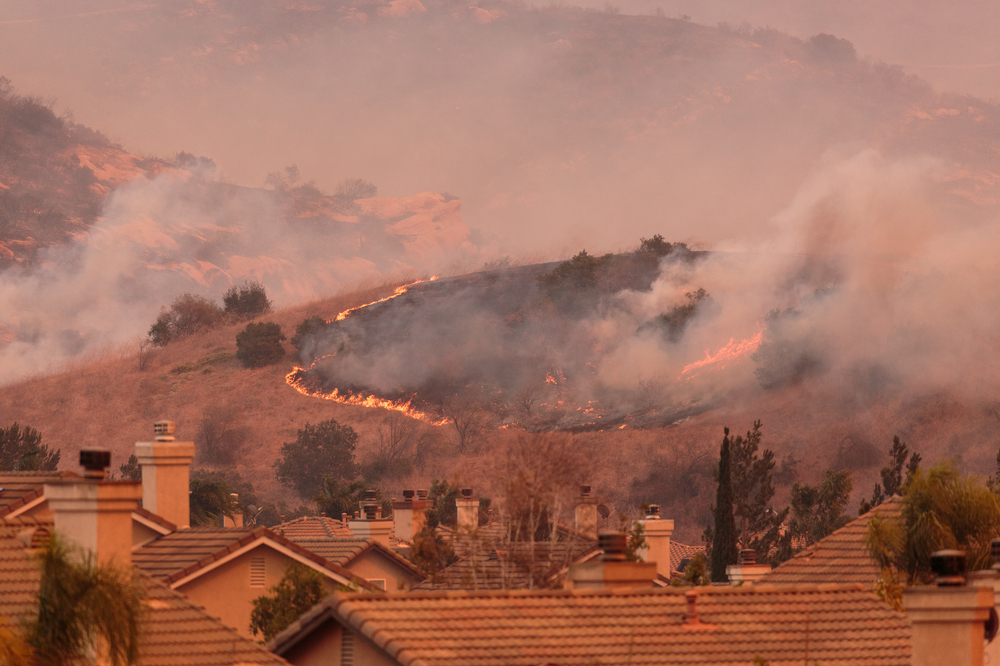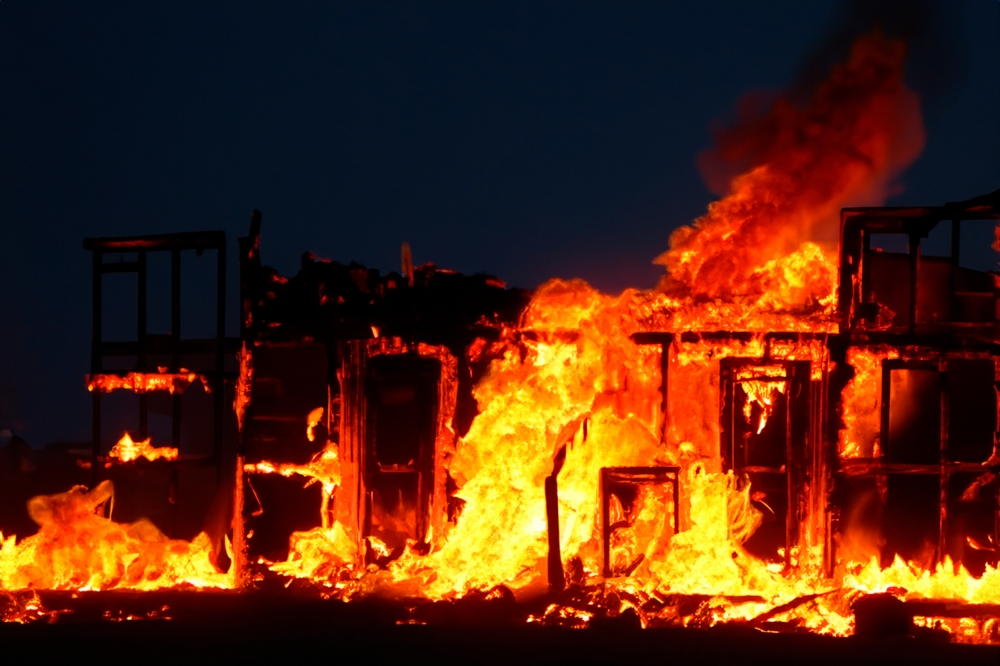Wildfires have occurred with increasing frequency and intensity in locations that pose a risk to human life and habitation, with further escalation expected as climate change worsens. As such, the design of wildfire-resistant buildings and even landscapes as a whole may become a pressing priority in some regions. This article will discuss some of the aspects that determine building survivability during wildfires and how buildings and communities can be made more fire-resistant.

Image Credit: Aarti Kalyani/Shutterstock.com
What Factors Influence Building Survival?
Vegetation
Ornamental vegetation and foliage on streets and around houses is a major propagator of wildfire into residential areas, particularly where large trees overhang into the property and there is no clear non-flammable boundary, such as a wall. However, despite having more available fuel, forested areas are not particularly more at risk than regions with only low-lying shrubbery, as wind speeds are generally higher in these locations, promoting fire spread.
Post-wildfire analysis suggests that vegetation reduction within a perimeter 30 meters around the house improves the probability of survival, though some locations in California or Portugal, for example, demand 60 and 50 meters of defensible space, respectively. This includes ensuring that gutters and vents are free from leaves and other debris that could act as an ignition point from only a small ember or even radiant heat only.
Landscape can also have a significant impact on house survivability, in particular placement on a slope, and especially where there is vegetation below the building, as the fire more easily spreads uphill than across flat landscapes.
Building Arrangement
The arrangement of houses and other buildings has been found to have an impact on the probability of destruction, the worst case being small isolated clusters of buildings that each possess a large perimeter contact with wildland vegetation and thus are more exposed to wildfire.
Rural buildings are more likely to have poorer road access for emergency services and be constructed from more flammable materials.
Building Materials
Even more densely populated areas are still at risk of property destruction resulting from wildfire, particularly where flammable building materials such as wood are predominantly used, though significant masonry, cement, or other non-flammable materials act as an impediment to the spread of fire, and structures at the center of such developments are generally safe.
Of the common building materials, stucco has proven to be superior to other materials such as masonry (brick), metal, and particularly wood, while tile has proven a superior roofing material to shingle, metal, shake (wood), or composite (typically fiberglass/asphalt). During the Pedrógão Grande wildfire in Portugal, where construction is typically ceramic, 61.8% of ignition points on lost houses were on the roof, and another 16% on the windows. In this context, double-paned windows improve house survivability, as well as glass specially designed to block radiant heat.
A study by Syphard et al. of wildfires in San Diego County, CA, USA lists the most contributing factors of building destruction by wildfires: building density, building age, positioning on a slope, the presence of vegetation, overhanging vegetation, distance to major roads, and building materials. Price et al. concluded similarly, though emphasizes defensible actions taken by residents, such as vegetation removal or wall construction, as defended houses during wildfires in east Australia were around three times as likely to survive than those not prepared in advance.
What Steps Can Be Taken to Mitigate Wildfire Risk?
Specially designed houses with wildfire resistance in mind can be made almost impervious to direct fire damage, firstly focusing on the primary risk factors discussed above, namely vegetation removal and the establishment of a defensible zone.
Roofs are rated in their fire resistance from Class A to Class C, the former being the highest protection and typically being constructed from materials such as clay, concrete, and some types of asphalt. Roofs can be further fireproofed with fiberglass or other chemical retardant coatings, while windows can be upgraded with double or triple-paned tempered glass, and walls with three-coat stucco for maximum fire resistance.

Image Credit: Fernando Astasio Avila/Shutterstock.com
Covering vents with fine wire mesh too narrow for embers to enter also blocks one of the most common ignition points, after the roof and windows. In a more extreme example of wildfire defense, specialized sprinkler systems can be installed in the roof and perimeter of buildings that continuously douse the area when turned on.
At the broader scale, towns, cities, and communities may need to be designed with wildfire defense in mind where increasing intensity and frequency are expected in coming years. Namely, focus is needed on constructing larger communities with good defensible zones, minimum perimeter contact with wildlands, and excellent road access for emergency services.
Of course, it is not desirable to remove significant portions of vegetation surrounding inhabited regions, and thus, landscaping and tree planting decisions that account for probable wildfires can alleviate the risk of significant loss. For example, European pines have demonstrated excellent fire resistance compared to many types of trees and act to slow wind speeds and slow wildfire spread in otherwise low shrubland areas where they are planted.
Pine forests are commonly planted in wildfire-affected regions where they can successfully grow for these reasons and also offer future recoverability to the area should another wildfire break out, owing to the serotinous cones of many pine species. These cones are “glued” shut by resin and can remain hanging on the tree for many years where the seeds inside mature.
When a wildfire occurs, this resin melts, releasing the mature seeds, which rapidly grow in the nourished soil. Many types of plants rely on wildfires to release their seeds, and thus may be at risk from overzealous efforts to eradicate wildfire. Increasingly, however, the value of allowing and containing natural wildfire or in engaging in controlled burns, namely the removal of underbrush and other flammable materials, is being recognized in wildfire-prone regions.
These types of strategies will likely play the most contributing factor in defending populated regions from wildfires in the future, as their increasing occurrence and effect on unprepared regions is unavoidable.
Urban Planning and Green Spaces: Balancing Development and Nature in Cities
References and Further Reading
Samora-Arvela, A., Aranha, J., Correia, F., Pinto, D. M., Magalhães, C., & Tedim, F.. (2023). Understanding Building Resistance to Wildfires: A Multi-Factor Approach. Fire, 6(1), 32. https://doi.org/10.3390/fire6010032
Fernandes, P. M., Vega, J. A., Jimenez, E. & Rigolot, E. (2008). Fire resistance of European pines. Forestry ecology and management, 256, 3. https://doi.org/10.1016/j.foreco.2008.04.032
Syphard, A. D., Brennan, T. J. & Keeley, J. E. (2017). The importance of building construction materials relative to other factors affecting structure survival during wildfire. International journal of disaster risk reduction, 21. https://doi.org/10.1016/j.ijdrr.2016.11.011
Disclaimer: The views expressed here are those of the author expressed in their private capacity and do not necessarily represent the views of AZoM.com Limited T/A AZoNetwork the owner and operator of this website. This disclaimer forms part of the Terms and conditions of use of this website.